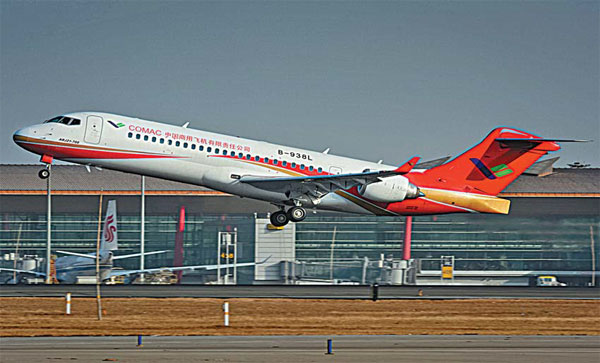Jet closer to market-entry clearance
Updated: 2015-01-09 07:20
By Wang Wen(China Daily Europe)
|
|||||||||||
Domestic aircraft first assessed by local officials using global airworthiness standards for large plane
Guo Yanghui, an engineer for aircraft manufacturer Commercial Aircraft Corp of China, has lived in Xi'an for four years.
His son was born in the capital of Shaanxi province in August. The 32-year-old plans to move his family to a new apartment he bought in Shanghai, where COMAC has its headquarters, but he doesn't know when they can move there.
|
The airworthiness certificate for the ARJ21-700 regional jetliner issued by civil aviation authorities on Dec 30 is displayed in Beijing by Jin Zhuanglong (right), chairman of Commercial Aircraft Corp of China. The certificate means the aircraft meets the authorities' safety requirements and has permission to enter the aviation market. Pei Xin / Xinhua |
|
An ARJ21-700 aircraft takes off from Beijing Capital International Airport on Dec 28. Guan Jianfei / China Daily |
"I work where my aircraft is located," he says.
Guo is a member of COMAC's field test team for the Advanced Regional Jet of the 21st century, or the ARJ21, the first regional jet developed by China.
The aircraft, which holds up to 90 seats, made its maiden flight in 2008.
Both its manufacturer and the Chinese aviation authorities had worked hard since then to certify the plane's airworthiness.
Guo and his colleagues provided technical support for the ARJ21's airworthiness certification tests in Yanliang district in Xi'an, which is known as a hub for Chinese aircraft manufacturing.
On Dec 30, the Civil Aviation Administration of China certified the ARJ21. COMAC's field test team will now be reduced from more than 200 members to about 100 in line with the manufacturer's plans.
It is the first time the CAAC has awarded a domestically made aircraft an airworthiness certification based on the CCAR-25-R3 regulation, which is equivalent to international airworthiness standards for large passenger aircraft.
Airworthiness is a measure of an aircraft's suitability for safe flight, and receiving certification means the ARJ21 meets the authority's safety requirements for a passenger aircraft.
The certification is also seen as a green light for the aircraft to enter the market.
The authority examines the aircraft's safety on behalf of passengers, says Shen Xiaoming, head of the airworthiness certification center of CAAC's East China bureau and director of CAAC's ARJ21 airworthiness certification team.
Just as with other crucial departments, the experts and engineers who work on the certification are responsible for the aircraft's airworthiness for its full operating life.
But without previous experience, the authority did not even know how to design the tests, he says, as the regulations only specified desired outcomes.
Thus, it took a long time for the authority to design every test from scratch, Shen says.
"The authority's capital and resources for airworthiness certification are limited," he says.
CAAC has two airworthiness certification centers, with the Shanghai center assessing transport aircraft based on the CCAR-25 regulation, while the center in Shenyang, Liaoning province, assesses general aviation aircraft based on the CCAR-23 regulation.
Currently, 275 employees of CAAC work on airworthiness certification, Shen says.
Generally speaking, certifying an aircraft's airworthiness requires a team of 80 employees, but CAAC has fewer than 70 people assessing the C919, an even larger passenger aircraft, he says.
The government is aware of the issue and is working to enlarge the airworthiness team.
The Shanghai center spent 13 million yuan ($2.09 million) sending five test pilots to train in the United States. The authority will also train six to 10 test pilots for C919 airworthiness certification, Shen says.
"The authority's airworthiness force will be strengthened in the future."
But CAAC still needs time to build its team as experts need to understand both airworthiness and aircraft design, Shen says.
The completion of the ARJ21's certification shows that the Chinese authorities are capable of examining passenger aircraft airworthiness, Shen says.
The Federal Aviation Administration, the US national aviation authority, also carried out a shadow review to assess CAAC's capability, and randomly inspected 53 of the more than 300 CAAC experiments on the ARJ21, Shen says.
The FAA's review is ongoing, and the two authorities will sign a bilateral agreement to verify CAAC's assessment capability after the review is completed.
COMAC will also apply for airworthiness certification for the ARJ21 from the European Space Agency and, with approval from the FAA and the ESA, the Chinese-manufactured aircraft will enter the international market.
COMAC deployed its outfield test team to Yanliang in 2009, together with the aircraft. Most of the ground test equipment was made there.
"I originally thought the work in Yanliang would last two or three years," says Ni Guomin, head of the team's technical support group.
The 68-year-old, who was supposed to retire years ago, was assigned to Yanliang in August 2009 to lead an 80-strong group consisting mainly of young engineers.
From the beginning, Ni and his apprentices were kept very busy as many problems were found with the plane, he says, and they had to work on weekends.
Another challenge for Ni was teaching his younger colleagues.
"We jokingly described it as 'grandpas teaching grandsons'," he says.
As the tests progressed, the young engineers became more experienced and the workload also eased.
Airplane problems became rare in 2014 and the staff could relax on weekends, Ni says.
Besides the staff of COMAC, the ARJ21's suppliers were also involved in the airworthiness examinations.
The jet was sent to the AVIC Aircraft Strength Research Institute, which is the only research center dedicated to aircraft strength in China, on Sept 28, 2007. Even now, although the aircraft has received airworthiness certification, an ARJ21 is still undergoing fatigue tests at the institute.
Takeoffs and landings are simulated on the aircraft to check its life span, which is designed to be 50,000 flying hours over 20 years.
The fatigue testing will take seven to eight years, as it simulates the aircraft's full working life, says Qiang Baoping, deputy director and chief engineer at the institute.
The aircraft also went through a three-and-a-half year static test in the institute to check its design strength.
"It was also the first time for us to work on passenger aircraft airworthiness certification," Qiang says.
The institute improved some of its equipment and test methods while working on the ARJ21 program, he says.
The ARJ21 is considered the start of China's passenger aircraft manufacturing, and all stakeholders, including the authority, manufacturers and suppliers, continue to work on the C919 and possibly later will work on the C929, a domestically made wide-body aircraft.
The strength research institute has built a facility for the C919 in Shanghai, next to the aircraft's assembly line.
Engineer Guo and his colleagues still take care of the aircraft in Yanliang, but some may be assigned to Shanghai to work on the C919.
"The C919 will take a shorter time to get airworthiness certification, as we now have experience from the ARJ21," CAAC's Shen says.
wangwen@chinadaily.com.cn
(China Daily European Weekly 01/09/2015 page21)
Today's Top News
Xi sends condolences to France over terror attack
Hunt for 2 in French shooting; 1 surrenders
2015: Change on and by the Internet
China nets 680 fugitives in anti-graft drive
Making a clean breast of it
Credit Suisse's China partner under investigation
Belarus' Domracheva named Europe's Athlete of 2014
China's influence in global film market expanding: report
Hot Topics
Lunar probe , China growth forecasts, Emission rules get tougher, China seen through 'colored lens', International board,
Editor's Picks

|

|

|

|

|

|







